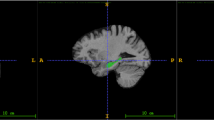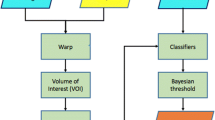Abstract
Alzheimer’s disease (AD) is an irreversible, progressive, and ultimately fatal brain degenerative disorder, no effective cures for it till now. Despite that, the available treatments can delay its progress. So, early detection of AD plays a crucial role in preventing and controlling its progress. Hippocampus (HC) is among the first impacted brain regions by AD. Its shape and volume are measured using a structural magnetic resonance image (MRI) to help AD diagnosis. Therefore, brain hippocampus segmentation is the building block for AD detection. This study’s main objective is to propose a deep learning Alzheimer’s disease hippocampus segmentation framework (DL-AHS) for automatic left and right hippocampus segmentation to detect and identify AD. The proposed DL-AHS framework is based on the U-Net architecture and estimated on the baseline coronal T1-weighted structural MRI data obtained from Alzheimer’s disease neuroimaging initiative (ADNI) and neuroimaging tools and resources collaboratory (NITRIC) datasets. The dataset is processed using the Medical Image Processing, Analysis, and Visualization (MIPAV) program. Besides, it is augmented using a deep convolutional generative adversarial network (DC-GAN). For left and right HC segmentation from other brain sub-regions, two architectures are proposed. The first utilizes simple hyperparameters tuning in the U-Net (SHPT-Net). The second employs a transfer learning technique in which the ResNet blocks are used in the U-Net (RESU-Net). The empirical results confirmed that the proposed framework achieves high performance, 94.34% accuracy, and 93.5% Dice similarity coefficient for SHPT-Net. Also, 97% accuracy and 94% Dice similarity coefficient are achieved for RESU-Net.















Similar content being viewed by others
References
Li H, Habes M, Wolk DA, Fan Y (2019) A deep learning model for early prediction of Alzheimer’s disease dementia based on hippocampal magnetic resonance imaging data. Alzheimer’s Dement 15(8):1059–1070
Sevigny J et al (2016) The antibody aducanumab reduces Aβ plaques in Alzheimer’s disease. Nature 537(7618):50–56
Wen J et al (2020) Convolutional neural networks for classification of Alzheimer’s disease: Overview and reproducible evaluation. Med Image Anal 63:101694
Jain R, Aggarwal A, Kumar V (2021) Chapter 1—A review of deep learning-based disease detection in Alzheimer’s patients. In: Jude HD (ed) Handbook of decision support systems for neurological disorders. Academic Press, pp 1–19
Ding J, Kong W, Mou X, Wang S (2019) Construction of a transcriptional regulatory network of Alzheimer’s disease based on PANDA Algorithm. Interdiscip Sci Comput Life Sci 11(2):226–236
Yang F et al (2020) Identification of key regulatory genes and pathways in the prefrontal cortex of Alzheimer’s disease. Interdiscip Sci Comput Life Sci 12(1):90–98
Hosseini-Asl E, Gimel’farb G, El-Baz A (2016) Alzheimer’s disease diagnostics by a deeply supervised adaptable 3D convolutional network 502
Nadal L et al (2020) Differential annualized rates of hippocampal subfields atrophy in aging and future Alzheimer’s clinical syndrome. Neurobiol Aging 90:75–83
Carmo D, Silva B, Yasuda C, Rittner L, Lotufo R (2021) Hippocampus segmentation on epilepsy and Alzheimer’s disease studies with multiple convolutional neural networks. Heliyon 7(2):e06226
Andersen P, Morris R, Amaral D, Bliss T, O’Keefe J (2006) The hippocampus book. Oxford University Press
Petersen RC et al (2010) Alzheimer’s disease neuroimaging initiative (ADNI). Neurology 74(3):201–209
Wang L et al (2003) Changes in hippocampal volume and shape across time distinguish dementia of the Alzheimer type from healthy aging. Neuroimage 20(2):667–682
Duraisamy B, Shanmugam JV, Annamalai J (2019) Alzheimer disease detection from structural MR images using FCM based weighted probabilistic neural network. Brain Imaging Behav 13(1):87–110
Dong H, Yang G, Liu F, Mo Y, Guo Y (2017) Automatic brain tumor detection and segmentation using U-Net based fully convolutional networks. In: Annual conference on medical image understanding and analysis, pp 506–517
Ghosh S, Das N, Das I, Maulik U (2019) Understanding deep learning techniques for image segmentation. ACM Comput Surv 52(4):1–58
Shaken M et al (2016) Sub-cortical brain structure segmentation using F-CNN’S. Proc—Int Symp Biomed Imaging 2016:269–272
Seo H et al (2020) Machine learning techniques for biomedical image segmentation: an overview of technical aspects and introduction to state-of-art applications. Med Phys 47(5):e148–e167
Singh SP, Wang L, Gupta S, Goli H, Padmanabhan P, Gulyás B et al (2020) 3D deep learning on medical images: a review. Sensors 20(18):5097
Kalavathi P, Christy AAA, Priya T (2017) Detection of Alzheimer disease in MR brain images using FFCM method. Comput Methods, Commun Tech Inf 140–144
Biju KS, Alfa SS, Lal K, Antony A, Akhil MK (2017) Alzheimer’s detection based on segmentation of MRI image. Procedia Comput Sci 115:474–481
Yamanakkanavar N, Choi JY, Lee B (2020) MRI segmentation and classification of the human brain using deep learning for diagnosis of Alzheimer’s disease: a survey. Sensors (Switzerland) 20(11):1–31
Shen D, Wu G, Suk H-I (2017) Deep learning in medical image analysis. Annu Rev Biomed Eng 19:221–248
Litjens G et al (2017) A survey on deep learning in medical image analysis. Med Image Anal 42:60–88
Li F, Tran L, Thung K-H, Ji S, Shen D, Li J (2015) A robust deep model for improved classification of AD/MCI patients. IEEE J Biomed Heal Inf 19(5):1610–1616
Zeng N, Zhang H, Song B, Liu W, Li Y, Dobaie AM (2018) Facial expression recognition via learning deep sparse autoencoders. Neurocomputing 273:643–649
Lin W et al (2018) Convolutional neural networks-based MRI image analysis for the Alzheimer’s disease prediction from mild cognitive impairment. Front Neurosci 12:777
Chen Y (2019) Intelligent systems reference library 171 deep learning in healthcare
Noh H, Hong S, Han B (2015) Learning deconvolution network for semantic segmentation. In: Proceedings of the IEEE international conference on computer vision, pp 1520–1528
Lguensat R, Sun M, Fablet R, Tandeo P, Mason E, Chen G (2018) EddyNet: a deep neural network for pixel-wise classification of oceanic eddies. In: IGARSS 2018–2018 IEEE international geoscience and remote sensing symposium, pp 1764–1767
Ronneberger O, Fischer P, Brox T (2015) U-net: Convolutional networks for biomedical image segmentation. Lect. Notes Comput. Sci. (includingSubser. Lect. Notes Artif. Intell. Lect. Notes Bioinformat) 9351:234–241
Dolz J, Desrosiers C, Ben Ayed I (2018) 3D fully convolutional networks for subcortical segmentation in MRI: a large-scale study. Neuroimage 170:456–470
Allioui H, Sadgal M, Elfazziki A (2019) Deep MRI segmentation: A convolutional method applied to Alzheimer’s disease detection. Int J Adv Comput Sci Appl 10(11):365–371
Sun J, Yan S, Song C, Han B (2020) Dual-functional neural network for bilateral hippocampi segmentation and diagnosis of Alzheimer’s disease. Int J Comput Assist Radiol Surg 15(3):445–455
Liu M et al (2020) A multi-model deep convolutional neural network for automatic hippocampus segmentation and classification in Alzheimer’s disease. Neuroimage 208:116459
Chitradevi D, Prabha S, Prabhu AD (2020) Diagnosis of Alzheimer disease in MR brain images using optimization techniques. Neural Comput Appl 7:223–237
Nobakht S, Schaeffer M, Forkert ND, Nestor S, Black SE, Barber P (2021) Combined atlas and convolutional neural network-based segmentation of the hippocampus from MRI according to the ADNI harmonized protocol. Sensors 21(7):2427
Chitradevi D, Prabha S (2020) Analysis of brain sub-regions using optimization techniques and deep learning method in Alzheimer disease. Appl Soft Comput J 86:105857
Noor MBT, Zenia NZ, Kaiser MS, Al Mamun S, Mahmud M (2020) Application of deep learning in detecting neurological disorders from magnetic resonance images: a survey on the detection of Alzheimer’s disease, Parkinson’s disease, and schizophrenia. Brain Inf 7(1):1–21
Jo T, Nho K, Saykin AJ (2019) Deep learning in Alzheimer’s disease: diagnostic classification and prognostic prediction using Neuroimaging data. Front Aging Neurosci 11:220
Liu X, Deng Z, Yang Y (2019) Recent progress in semantic image segmentation. Artif Intell Rev 52(2):1089–1106
Russakovsky O et al (2015) Imagenet large scale visual recognition challenge. Int J Comput Vis 115(3):211–252
Goodfellow IJ, Pouget-Abadie J, Mirza M, Xu B, Warde-Farley D. Generative adversarial nets, pp 1–9
Frid-Adar M, Diamant I, Klang E, Amitai M, Goldberger J, Greenspan H (2018) GAN-based synthetic medical image augmentation for increased CNN performance in liver lesion classification. Neurocomputing 321:321–331
Venu SK, Ravula S (2021) Evaluation of deep convolutional generative adversarial networks for data augmentation of chest x-ray images. Futur Internet 13(1):1–13
Deepak S, Ameer PM (2019) Brain tumor classification using deep CNN features via transfer learning. Comput Biol Med 111:103345
Eelbode T et al (2020) Optimization for medical image segmentation: theory and practice when evaluating with dice score or Jaccard index. IEEE Trans Med Imaging 39(11):3679–3690
Author information
Authors and Affiliations
Corresponding author
Ethics declarations
Conflict of interest
The authors declare that they have no conflict of interest.
Additional information
Publisher's Note
Springer Nature remains neutral with regard to jurisdictional claims in published maps and institutional affiliations.
Rights and permissions
About this article
Cite this article
Helaly, H.A., Badawy, M. & Haikal, A.Y. Toward deep MRI segmentation for Alzheimer’s disease detection. Neural Comput & Applic 34, 1047–1063 (2022). https://doi.org/10.1007/s00521-021-06430-8
Received:
Accepted:
Published:
Issue Date:
DOI: https://doi.org/10.1007/s00521-021-06430-8




